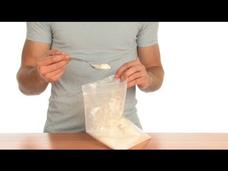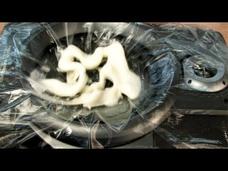Crash Course
Fluids in Motion: Crash Course Physics #15
How do fluids act when they are moving? A thorough video lesson explains the characteristics of fluids while in motion. Building from the previous lesson in the series, the 15th installment of a Crash Course physics series provides an...
Crash Course
Fluids at Rest: Crash Course Physics #14
Keep the knowledge flowing in your physics classroom! An in-depth video lesson discusses the characteristics of fluids. The narrator includes Pascal's Principle and Archimede's Principle as well as buoyant force. This is the 14th lesson...
Teacher's Pet
Phase Diagrams
This is one phase you'll enjoy going through with your class! Young chemists discover the components of phase diagrams in a video lesson. The narrator discusses temperature and pressure, then shows how their interaction affects the state...
Fuse School
What is Brownian Motion?
How do liquids and gases affect the particles placed into them? Young chemists witness the phenomena first described by scientist Robert Brown known as Brownian Motion. The third installment in a 14-part series on solids, liquids, and...
Veritasium
States of Matter
What makes water icy? Explore a range of theories from patrons at a public skating rink in an interview-style video. The narrator leads participatns through the phase change all the way to the molecular level, where less movement...
Crash Course
A Brief History of the Universe
No one was actually there to see the birth of the universe, but years of collaboration between physicists and mathematicians allow us to glimpse all but a fraction of a second of it. A narrated journey shows the phase changes...
Fuse School
3 States of Matter: Solids, Liquids and Gases
Start your states of matter unit off right with an engaging video! Before scholars can write and balance equations or predict products, knowledge of the three main states of matter is essential. The first in a 14-part series...
Project WET Foundation
The Incredible Journey
Go on an incredible journey called the water cycle with a video that details the ins and outs of water, its various forms, and place on planet Earth.
Bozeman Science
Matter
In 1924, Bose and Einstein predicted a fifth state of matter. The prediction proved to be true in 1995 and is referred to as the Bose-Einstein condensation. This video discusses the concept of matter, all five states of matter, and what...
DoodleScience
Hydraulics
Introduce the basics of hydraulics with an informative video. It explains liquids, compression, force multipliers, and pressure. It concludes with examples of when hydraulics are used such as pistons, car brakes, landing gears, and car...
DoodleScience
The Kinetic Theory
Amaze class members with the fact that solids, liquids, and gases all have the same particles. Kinetic theory explains how the particles loosen their bonds when given energy. Solids become liquids and liquids become solids.
Crash Course Kids
Oobleck and Non-Newtonian Fluids
Find out how matter fits into more than one state with this entertaining video that details non-newtonian fluids and a step-by-step instruction for how to make oobleck.
Crash Course Kids
(LEGO) Block Party
Get your blocks out! It's time to start building and learning about mass! Enthusiastic chemists get in-depth information about the conservation of mass and the way it applies to chemical changes.
Crash Course Kids
Chemical Changes
Your enthusiastic chemists will flip over this entertaining video about matter and its chemical changes! Take an in-depth look into what chemical changes are and the evidence that is observed, such as color, smell, and heat. Then,...
Crash Course Kids
What's Matter?
What is matter? Find out in this entertaining video that thoroughly details how matter has both volume and weight, but looks different as a liquid, solid, and gas.
Crash Course Kids
Part(icles) of Your World
Learn about the states of matter with an entertaining physical science video. With captioned explanations and real-world examples of changes states of matter, the video is an excellent addition to your lesson or homework assignment.
Steve Spangler Science
Homemade Ice Cream - Sick Science! #041
Here is the recipe for making ice cream in a couple of zip-top plastic bags. It is a fun way to demonstrate phase changes, especially when the weather is hot! Use this in your elementary science curriculum when introducing the states of...
Curated OER
Cornstarch Monsters
Using sound waves, Steve Spangler demonstrates the properties of a non-Newtonian fluid. When the fluid is placed on an amplifier, it changes into the most amazing shapes. Your class will love demonstrating this process in class.
Steve Spangler Science
Play and Freeze - Having Fun Making Ice Cream
Steve Spangler has created a toy that relies on science to make ice cream! He uses a ball with two cylinders inserted. One contains rock salt and water, while the other contains the ice cream ingredients. Once sealed, a family kicks the...
Curated OER
Dry Ice Fun for a Spooky Halloween
Create a cauldron of bubbling fun with this Halloween-themed demonstration idea. Using dry ice, Steve Spangler creates a crystal ball. If you compare the sublimation of dry ice to the melting of water ice, it is a wonderful way to...
Steve Spangler Science
Cornstarch Monsters - Cool Science Experiment
Using sound waves, Steve Spangler demonstrates the properties of a non-Newtonian fluid. When the fluid is placed on an amplifier, it changes into the most amazing shapes. Your class will love demonstrating this process in class.
Steve Spangler Science
Cornstarch Monster - Sick Science! #055
Make a strangely-moving "monster" out of cornstarch and water. The mixture produces a colloid with properties of both a liquid and a solid. Place the material over a stereo speaker, turn up the music, and watch it dance! This is a fun...
Steve Spangler Science
Amazing 9 Layer Density Tower - Sick Science! #012
This is a strong visual display of density. It requires a mountain of materials and is quite messy, so you most likely will not want to have lab groups perform this activity. You could demonstrate it for your class when exploring the...
Curated OER
Energy and the Four States of Matter Solid Liquid Gas and Plasma
There are four states of matter: solid, liquid, gas, and plasma. As this clip describes, the key to changing the states of matter is the addition or subtraction of energy. Learn about molecules, heat, plasma, and the science behind...























